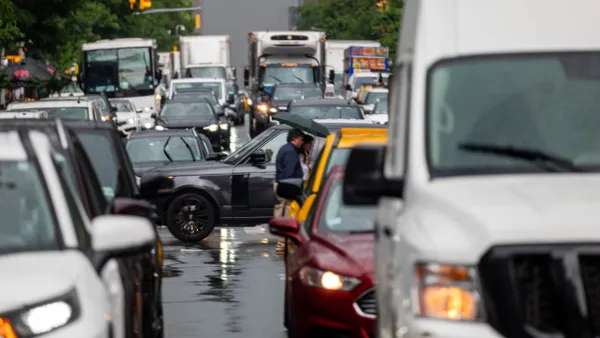Dive Brief:
- Previously undesirable warehouse spaces are now in demand thanks to the growth of delivery services, The Wall Street Journal reported last week.
- The reason: a growing need for e-commerce supply chains, as more shoppers eschew stores and malls in favor of doorstep delivery despite potential time delays.
- The new shopping infrastructure is simultaneously leading to a decline of the traditional mall or shopping favor, forcing their elimination or transformation to entertainment centers. In the future, shopping will be done from home and malls will become public spaces, the Journal reports.
Dive Insight:
The Journal report highlights a symptom of a general shift in the economy, which is changing supply chains and the cities they run through.
The internet and rise of e-commerce, where apps can facilitate anything from rides to laundry or meal delivery, has transformed consumer expectations to an on-demand economy. Now the digital infrastructure is in place to support this economy, the physical infrastructure must catch up.
Supply chains were the first step. Retail and last-mile delivery giants have been struggling to meet customers' 2-day shipping expectation at a profit. Last fall, FedEx, UPS and Amazon all showed at least part of their hand, as they boasted massive investments in a nationwide network of warehouses. In order to meet expectations, logistics providers had to build a chain of distribution centers, with metropolitan hubs backing a plethora of smaller, city-level warehouses.
Now, it's the city's job to ensure the economic transition goes smoothly.
Besides repurposing fading shopping centers and run-down warehouses, cities can do a lot to accommodate residents and suppliers working within the new delivery paradigm. With urban freight delivery growth expected to expand 40% by 2050, municipal and business leaders must collaborate to develop smart logistics infrastructure and ensure congestion does not get out of hand.
Several examples include the utilization of shopping malls as logistics hubs, the establishment of off-hour delivery times, allowing autonomous or low-emission urban delivery vehicles, and facilitating curbside deliveries with sensors. Smart cities can also share traffic data with logistics personnel to avoid aggravating traffic jams.
If one thing is certain, as the Journal points out, it's that the cities of the future will work differently; and at the heart of their success will be the efficiency urban e-commerce.











